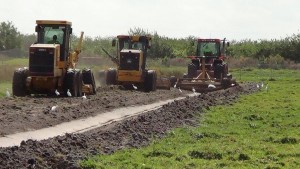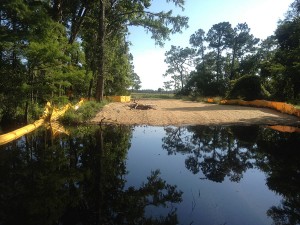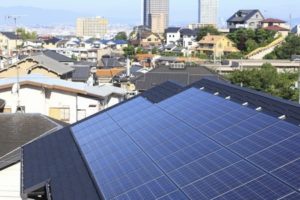Enviro-Tech Systems, Inc. is proud to have been awarded the construction portion and to have preformed the construction work for the Nicodemus Slough Project. We feel honored to have been apart of the team that will help the Caloosahatchee River and its estuary during heavy rain events and flooding conditions. See article below for more information on this project.
State water managers are putting the final touches on a storage project that should help the Caloosahatchee River and its estuary during heavy rain events and flooding conditions.
Called Nicodemus Slough, the $28 million project sits on 16,000 acres northwest of Moore Haven, just west of Lake Okeechobee. Water, upward of 11 billion gallons, will be stored on this land, mostly during late summer and fall. The idea is to pull billions of gallons from Lake Okeechobee so that coastal estuaries such as the Caloosahatchee and St. Lucie (on the east coast) won’t be hit so hard during large releases from the lake.
Large releases can kill sea grasses and oyster beds, feed algal blooms and cause fish kills.
The Caloosahatchee and St. Lucie rivers were artificially connected to Lake Okeechobee as a way to drain the lake and open the Everglades to development. Water laden with nutrients flows into the lake each year from the north. The water contains so much nutrients that it can’t be legally discharged onto another property — so water that would be going to Everglades National Park is instead going west and east to the Gulf of Mexico and Atlantic Ocean.
“We raise the water, and as the water works its way west, we’re basically pushing water uphill and letting gravity do the rest,” said Jeff Needle, an engineer and project manager for the South Florida Water Management District. “We’re restoring a slough and providing more habitat for birds.”

A pair of sandhill cranes feed in the Nicodemus Slough in Glade County. Water was pumped from Lake Okeechobee into the slough to help with storage. (Photo: Andrew West/The News-Press)
Construction started in November 2013 and is in the final stages. District engineers, along with help from the property managers (most of the land is leased from the Lykes Brothers Inc. at $2 million a year) started pumping water to Nicodemus earlier this year. The project is now fully functional and is taking Lake Okeechobee water while the Army Corps continues releases to prepare for the coming rainy season.
“This is a temporary step in the right direction,” Needle said. “But this is the best we have right now.”
These types of projects are designed to mimic historic conditions by keeping water on the landscape for as long as possible. An elaborate drainage system has been built over the past century to send fresh water to coastal areas as fast as possible. Turns out that strategy is good for farmers and some landowners but terrible for the environment, so taxpayers are spending billions of dollars to replumb the Everglades.
Water quality scientists and advocacy groups are hoping the project will help ease the freshwater load on the Caloosahatchee estuary during large rain events.

A large alligator basks in the sun next to a canal that is part of a project on the Nicodemus slough in Glades County. Water is being pumped uphill into the slough by the South Florida Management District to alleviate Lake Okeechobee water levels and to keep water from being sent down the Caloosahatchee River. (Photo: Andrew West/ The News-Press)
“We’re interested in (Nicodemus) and any storage to prevent excess amounts of water flowing down the Caloosahatchee,” said Rick Bartleson, a water quality scientist at theSanibel-Captiva Conservation Foundation. “It’s sort of a drop in the bucket for how much storage we need, so we’re trying to help them find more projects like that.”
Bartleson said the Nicodemus project will remove about 50 cubic feet per second of water flows at the Franklin Lock and Dam in Olga. During extremely heavy flows in 2013, flows at Franklin Lock were over 10,000 cubic feet per second.
Looking ahead, some environmental groups lauded Nicodemus Slough, saying these types of projects are needed to ensure the health of coastal estuaries such as the Caloosahatchee.
“We’ve been very impressed with the design and we certainly hope it works,” said Eric Draper, director of Florida Audubon. “It’s a big chunk of water, and that will help because every bit of water we can take off the lake and store is good for the estuaries.”
Conditions in the Caloosahatchee are rarely right — there’s either too much water blasting down the river (enough to send freshwater plumes 15 miles off Sanibel) or so little flow that salt water works its way inshore.

Water pumped in from Lake Okeechobee fills the Nicodemus Slough in Glades County. (Photo: Andrew West/The News-Press)
Nicodemus and other, smaller water storage projects should help cut down on future heavy releases from Okeechobee.
The reconstructed Nicodemus Slough is also connected to a canal that feeds into Lake Hicpochee, the former headwaters of the Caloosahatchee and another water management district water project for this region.
The project is also a public-private partnership, where the state pays Lykes Brothers for the use of the land and to operate the pumps. Draper said this style of water management is good for taxpayers because it lowers the cost and speeds up the process.
“The public is getting the benefit of this storage faster and cheaper than if the government built the project,” he said.
Connect with this reporter: ChadGillisNo1 on Twitter.
Nicodemus Slough by the numbers
- 16,000: acres in size
- 11: Billion gallons of water of storage
- $28: Million in costs
- 8: Years land will be leased from Lykes Brothers Inc.
- 6: Weeks it takes pumps to fill the slough
- 2,000: Acres of the slough are protected wetlands


 An excavation is no simple task. In fact, it is arguably one of the most crucial parts of the construction process because it lays the foundation for every other phase of a building project. It only takes one miscalculation to send an entire project off its course and turn a budget upside down, so these keys to a successful excavation should always be observed.
An excavation is no simple task. In fact, it is arguably one of the most crucial parts of the construction process because it lays the foundation for every other phase of a building project. It only takes one miscalculation to send an entire project off its course and turn a budget upside down, so these keys to a successful excavation should always be observed. It’s no secret that water is absolutely essential to life. Without supplies of freshwater, plants, animals, and humans alike would languish and eventually die. In fact, millions of people around the world already suffer from a lack of safe, clean freshwater due to climate, location, and pollution complications. This makes it the responsibility of those in the developed world to counteract this imbalance by harnessing water sources that would otherwise go to waste instead of placing more strain on mainstream water sources.
It’s no secret that water is absolutely essential to life. Without supplies of freshwater, plants, animals, and humans alike would languish and eventually die. In fact, millions of people around the world already suffer from a lack of safe, clean freshwater due to climate, location, and pollution complications. This makes it the responsibility of those in the developed world to counteract this imbalance by harnessing water sources that would otherwise go to waste instead of placing more strain on mainstream water sources.  Unless humankind as a whole decides that it is time to start living in mud huts again, the need for construction isn’t going anywhere. This means that construction will need to adapt to the ever-changing needs of our environment and economy, and the green building movement is proof of this evolution. Sustainable construction technologies are becoming more important than ever as the construction industry makes environmental consciousness a major goal. Check out these growing trends to understand what all homes and buildings may incorporate in the very near future.
Unless humankind as a whole decides that it is time to start living in mud huts again, the need for construction isn’t going anywhere. This means that construction will need to adapt to the ever-changing needs of our environment and economy, and the green building movement is proof of this evolution. Sustainable construction technologies are becoming more important than ever as the construction industry makes environmental consciousness a major goal. Check out these growing trends to understand what all homes and buildings may incorporate in the very near future.

